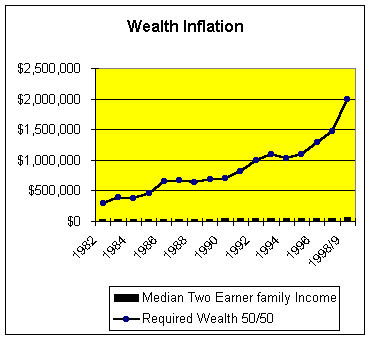Allow me to introduce an Eternal Truth: You can never have enough money.
No, cross that out. You will never have enough money.
I found this truth when I discovered a new and dangerous malady for those approaching retirement. Wealth inflation.
Wealth inflation is the incredible rise in the amount of wealth you need to sustain yourself in retirement. Indeed, even as the rise in the consumer price index has declined from double digits in the early eighties to under 3 percent this year, the amount you need to have in savings has ballooned at about 13 percent a year, compounded.
The primary evidence is my Life of Riley Index. First introduced in 1989 and most recently revisited in 1995, it is an index of the amount of money we need to be independently middle class.
Not rich, mind you. Just enough of a nest egg to be a privately funded Joe and Jane Six Pack. The major benefit you have as a Life of Riley family is that you don’t have to go to work every morning like the Jones do. Among the smaller benefits: you can do your shopping in light traffic; you avoid big vacation crowds; and you don’t have to wonder whether you’ll ever get anything back for your FICA tax payments because you don’t make them. Better still, you don’t have any work related expenses, can live in your Levis (or your robe) as god meant you to live, and can own a house with no relationship to a major highway. For better or worse, you won’t be on TV until Lifestyles of the Rich and Famous is replaced by Lifestyles of the Humble and Obscure.
So what is the price tag on humility and obscurity?
Try something a tad under $2 million. Up from a piddling $298,332 as recently as 1982. That’s a lot more money than most people had in 1982 and tons more than most people have in 1998.
Even before July, August, and September.
Mr. Greenspan may be winning the battle against price inflation but he has capitulated on the wealth inflation front.
The figures in the index are the consequence of some basic facts: there has been a long decline in interest rates and an equally long decline in the yields on common stocks. Combine that with the rising median income for two earner families (the most common family type) and you can figure out how much money you need to be independently middle class.
If you had a portfolio that was 50/50 stocks and bonds in 1982, you needed just under $300,000 to be independently middle class. The figure doubled by 1986 and doubled again by 1996. Additional figures are included for a portfolio that is 100 percent common stocks. However you invest your savings, you need an extraordinary amount of money.
The Life of Riley Index Hits A New High

| Year | S&P 500 Yield | 5Year Treasury Yield | Median Two Earner family Income | 100% Stocks | 50/50 Stocks & Bonds |
|
1982 |
5.81% |
13.01% |
$28,073 |
$483,184 |
$298,332 |
|
1983 |
4.40% |
10.79% |
$29,808 |
$677,455 |
$392,469 |
|
1984 |
4.64% |
12.26% |
$31,707 |
$683,341 |
$375,231 |
|
1985 |
4.25% |
10.12% |
$33,411 |
$786,141 |
$465,010 |
|
1986 |
3.49% |
7.30% |
$35,108 |
$1,005,960 |
$650,751 |
|
1987 |
3.08% |
7.94% |
$36,799 |
$1,194,773 |
$667,858 |
|
1988 |
3.64% |
8.47% |
$38,702 |
$1,063,242 |
$639,174 |
|
1989 |
3.45% |
8.50% |
$40,658 |
$1,178,493 |
$680,469 |
|
1990 |
3.61% |
8.37% |
$42,146 |
$1,167,479 |
$703,606 |
|
1991 |
3.24% |
7.37% |
$43,623 |
$1,346,389 |
$822,300 |
|
1992 |
2.99% |
6.19% |
$45,653 |
$1,526,856 |
$994,619 |
|
1993 |
2.78% |
5.87% |
$47,424 |
$1,705,899 |
$1,096,509 |
|
1994 |
2.82% |
6.68% |
$48,970 |
$1,736,525 |
$1,030,947 |
|
1995 |
2.56% |
6.77% |
$50,989 |
$1,991,758 |
$1,093,012 |
|
1996 |
2.19% |
6.07% |
$53,361 |
$2,436,575 |
$1,292,034 |
|
1997 |
1.77% |
5.77% |
$55,443 |
$3,132,373 |
$1,470,637 |
| 1998/9 |
1.57% |
4.23% |
$57,660 |
$3,672,611 |
$1,988,276 |
Sources: Federal Reserve Bank of Dallas; Census Bureau; Bloomberg; Economic Indicators. Median income for 1998 is estimated.
Is there a bottom line here?
I’m afraid so.
Don’t give up your day job.
This information is distributed for education purposes, and it is not to be construed as an offer, solicitation, recommendation, or endorsement of any particular security, product, or service.
Photo: Pixabay
(c) A. M. Universal, 1998
